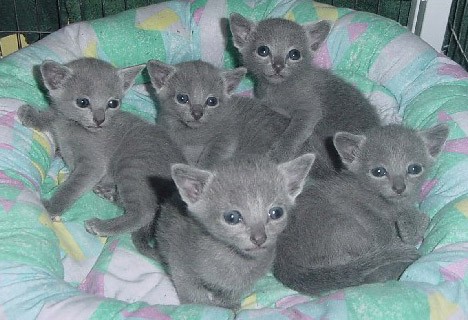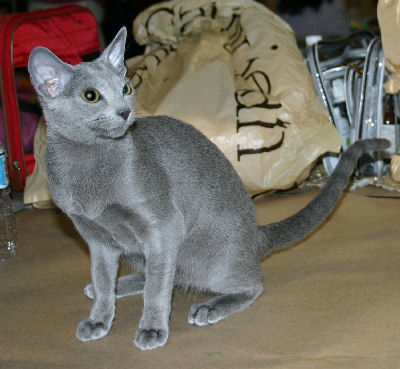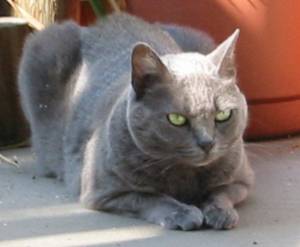



|
Russian Blue Description
The gentle and affectionate Russian Blue is easily distinguished from others by its short, blue coat tipped in silver, and stunning emerald eyes. The unique head shaped, best described as cobra like, is a medium sized wedge; it is neither long nor tapering, short nor massive. The muzzle is blunt and flows into the wedge smoothly. There should be a slight upturn to the mouth that gives the cat the impression of smiling.
The ears are rather large, with tips that are more pointed than round. They are thin and translucent with little furnishing and set far apart, as much on the top of the head as on the side. The eyes should be wide set, and aperture rounded in shape. They should be a deep and vibrant green.
Russian Blues sport a fine boned body, long and muscular with a lithe and graceful carriage. The legs are long and fine boned, ending in slightly rounded paws.
The unique coat is short and dense, fine and plush; a double coat that stands out from the body. It has a distinct soft and silky feel and is an even bright blue throughout with silver tipped guard hairs that give a silver sheen or lustrous appearance.
Russian Blue Temperament
Quiet and clean, the Russian Blue is a playful and loving pet. They tend towards shyness with strangers, disappearing completely or ducking behind chairs while evaluating the new individual, but are devoted and affectionate with those they call their own. They do not do well in households with many pets due to their shyness. They are perfect for the modern home as they are an undemanding breed and will entertain themselves if left alone.
Russian Blue Care
The Russian Blue requires minimal grooming. Petting will take care of brushing needs and they need only an occasional nail clipping. They are, however, very picky about the state of their litter box and will fuss until it is clean enough for them.
Russian Blue History
Little is known of the natural origins or history of the Russian Blue. Many believe they originated in the Archangel Isles of Northern Russia and may have been hunted for their plush and beautiful coats. Their introduction to England and Northern Europe was likely brought about by sailors and they are rumored to have been the royal cat of the Czars and a favorite pet of Queen Victoria.
It is known that they were first shown in London's Crystal Palace in 1875 as the Archangel cat in a the blue color class, as cats were shown by coat color rather than by breed or type. They did not receive their own class until 1912. Though they were introduced to America in the early 1900's, American breeders did not begin working with them until after WWII and it is their work that has set the standard we know today. They combined the English blood of the British Shorthair for the plush coat and the Scandinavian line for the emerald eyes. In the 1960's their popularity soared and they are now a home and show favorite.
|